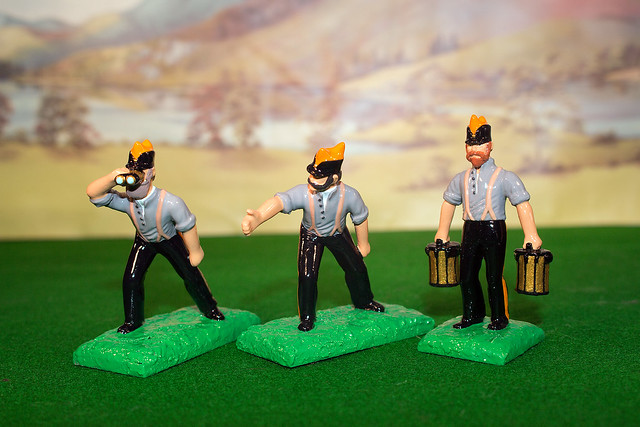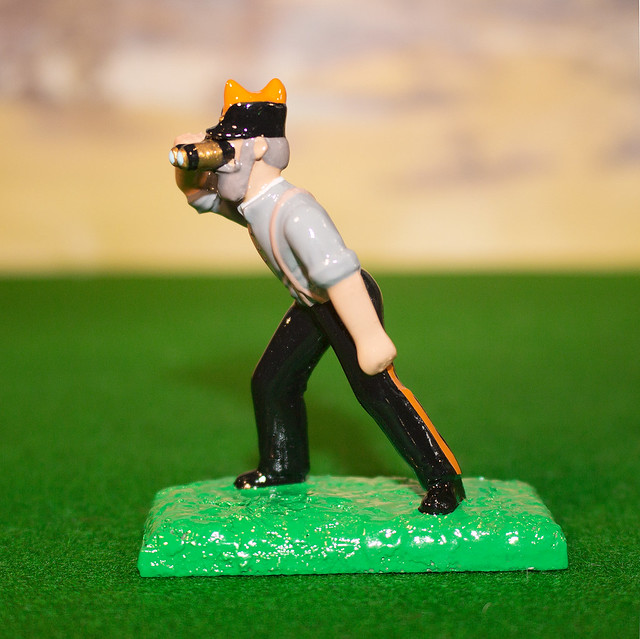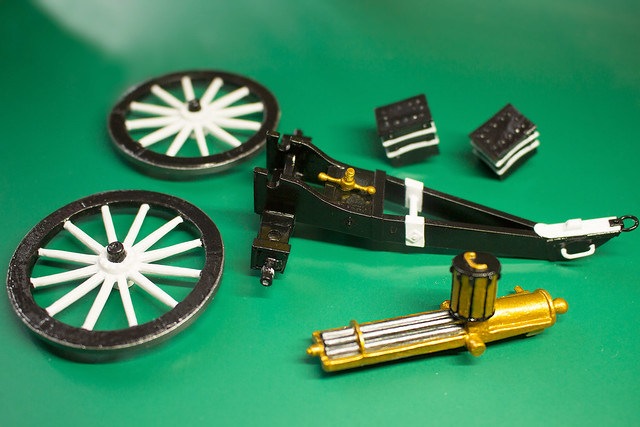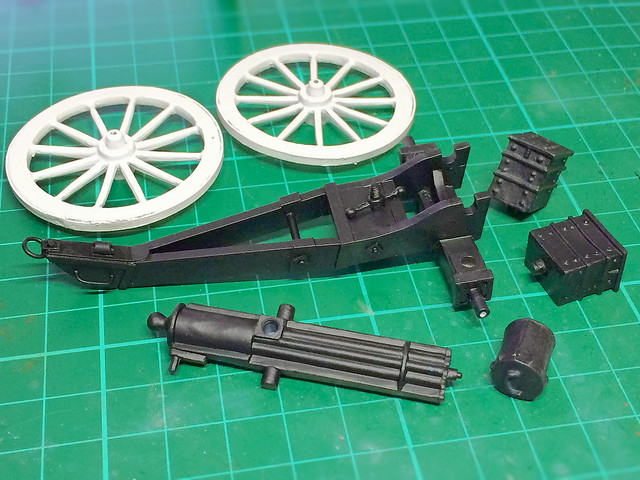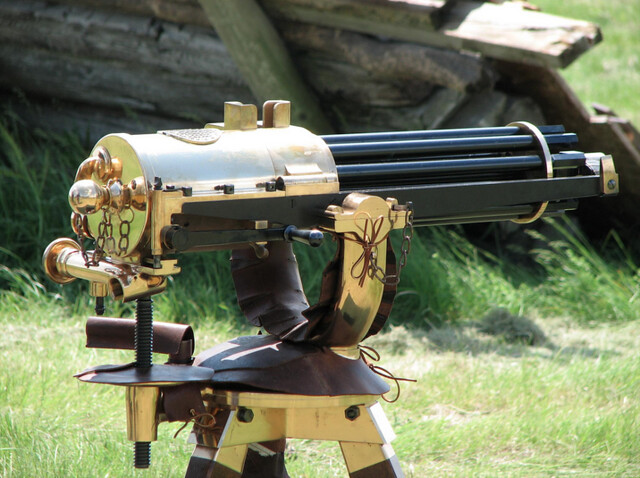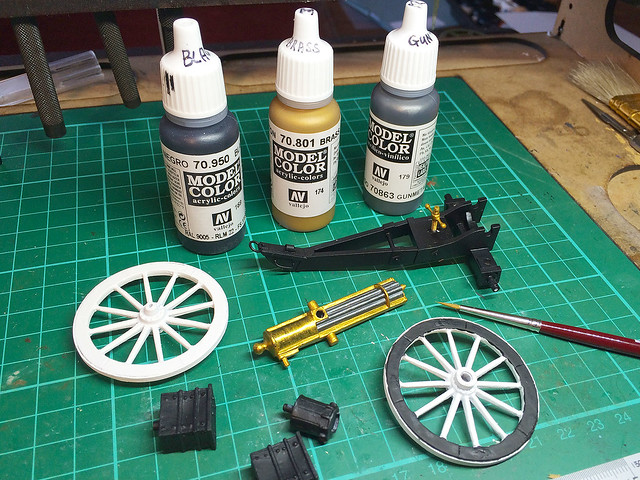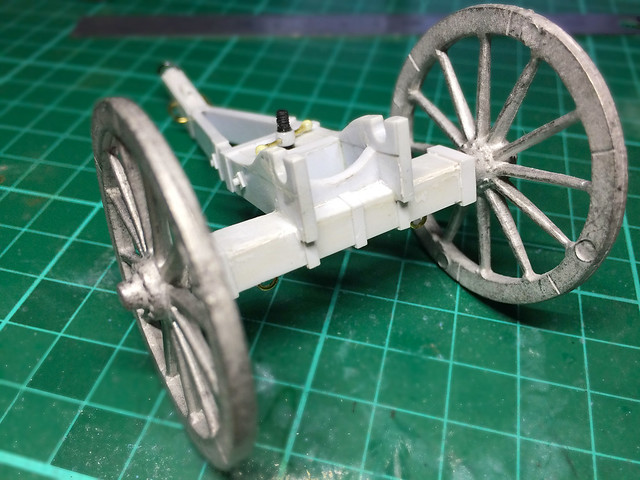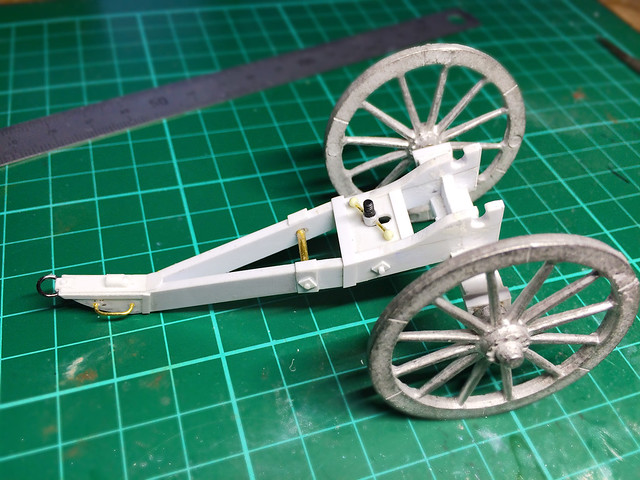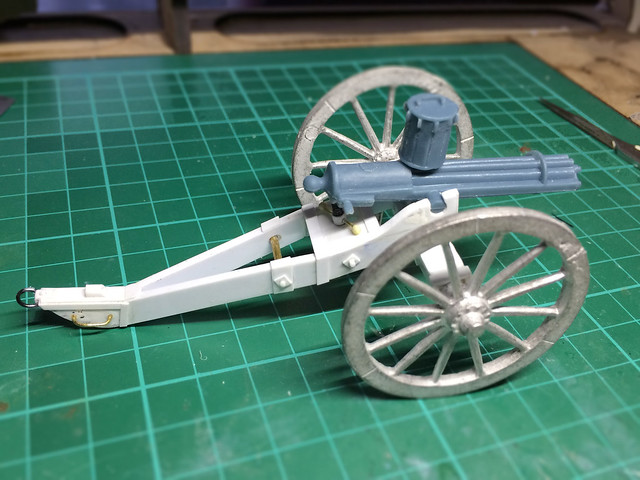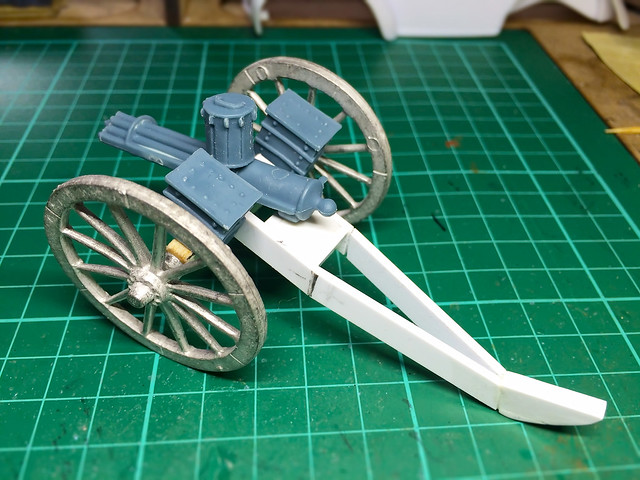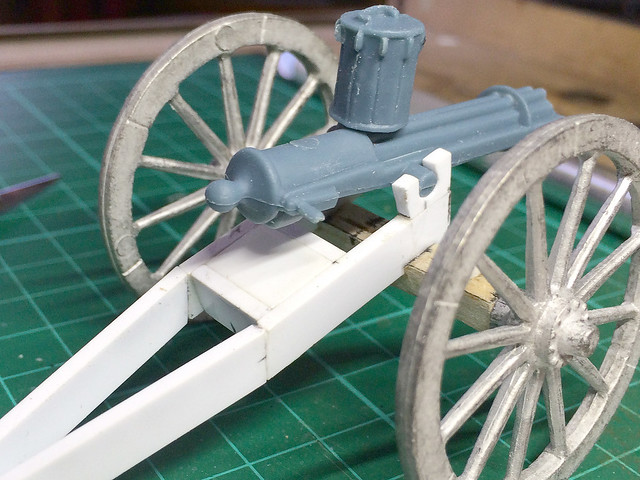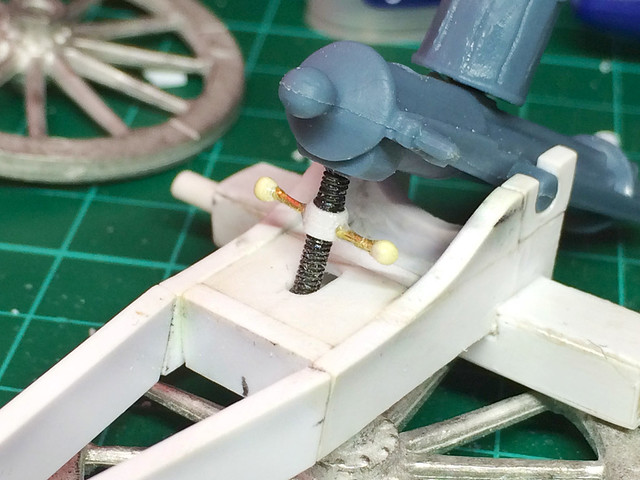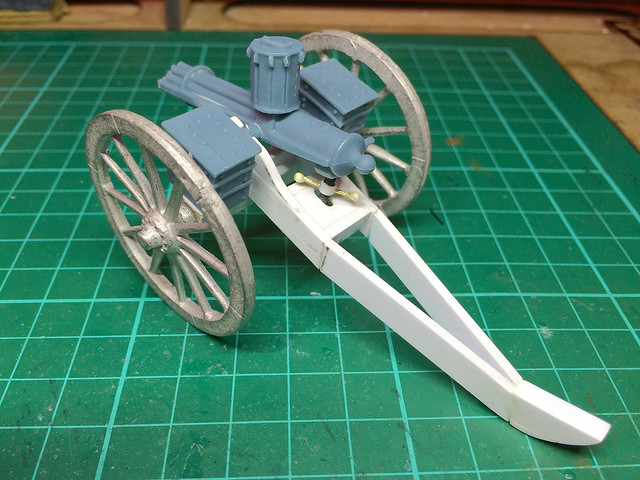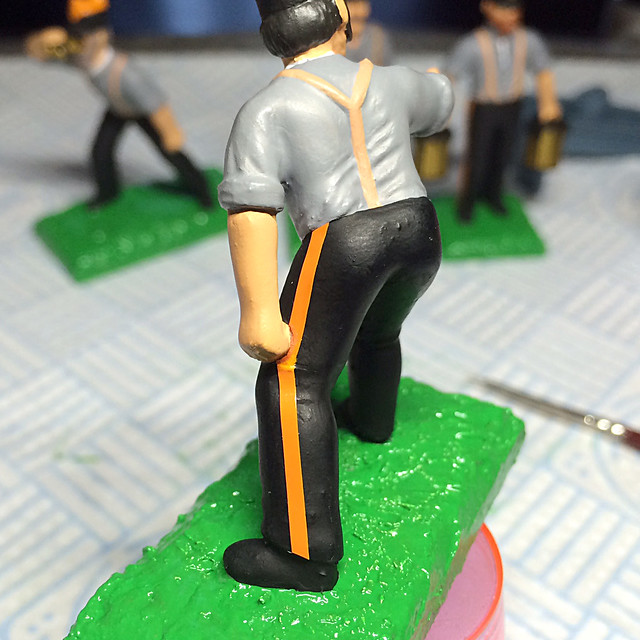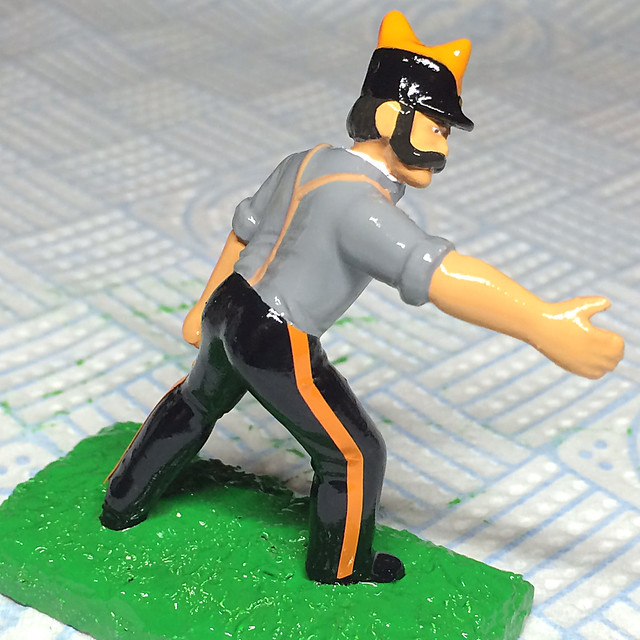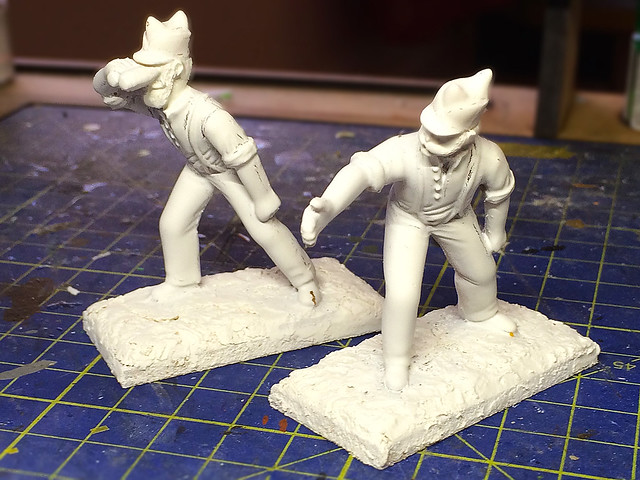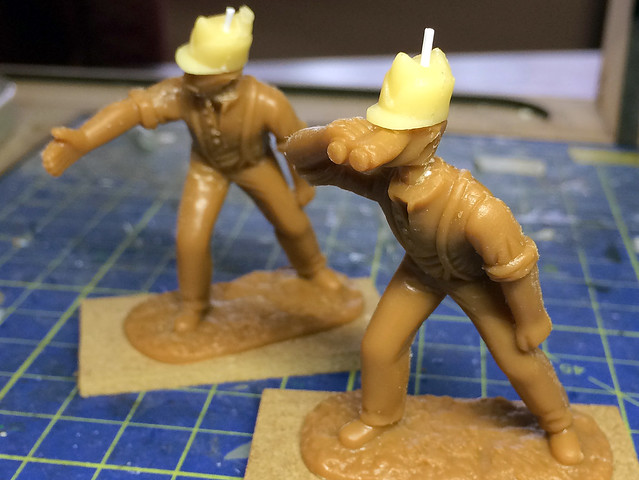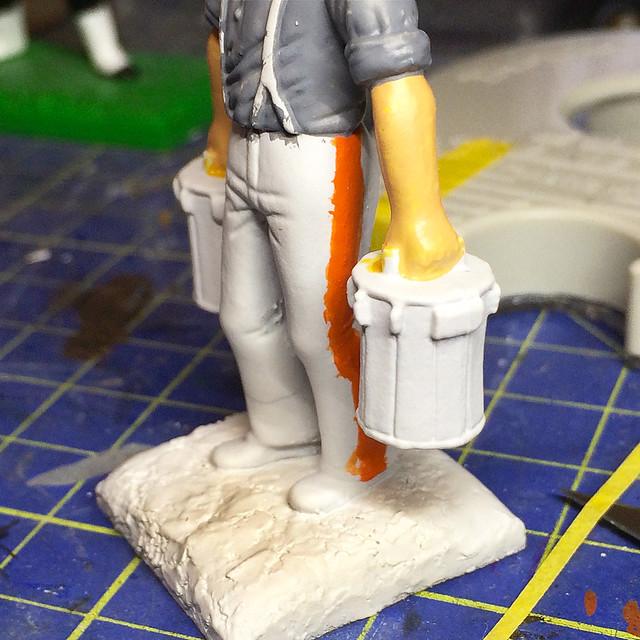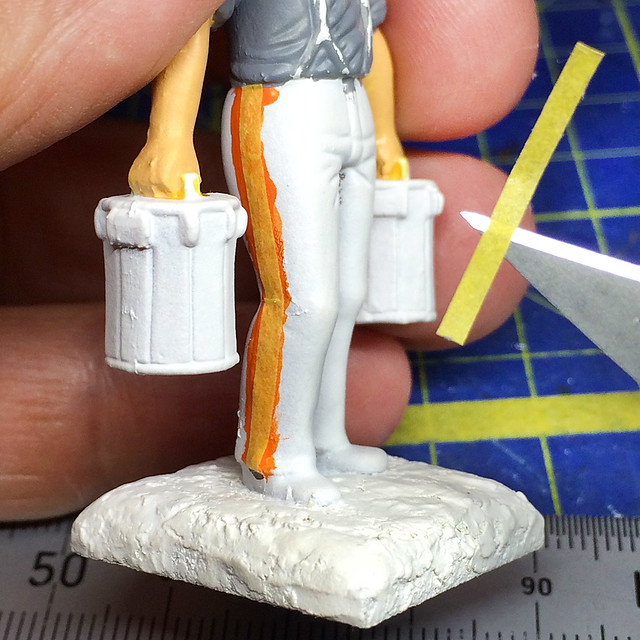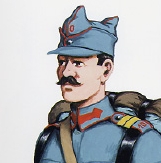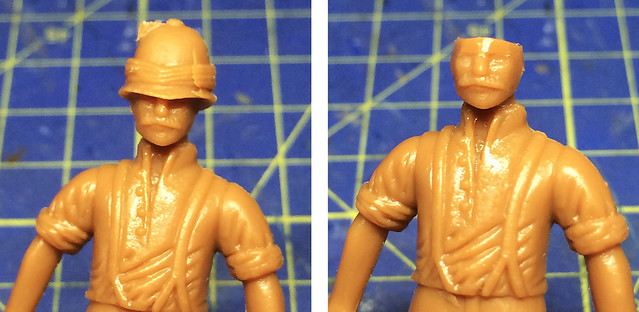Just a small update on my Burkish light infantry regiment, I'm on the last leg - painting the 'command' group (if that's the correct term for the senior NCO and officer). They have a slightly different uniform than the 'other ranks'...
I'm about halfway through painting the figures, so as you can see some of the coats are a bit patchy. But I'm getting through the job pretty quickly (for me).
I'm toying with giving the officer a grey beard, and the flag-carrier needs a flag! This is in the works as well.
Being the Ethereal Embassy for the Kingdom of Molatero and it's participation in the Funny Little Wars
Showing posts with label AiP. Show all posts
Showing posts with label AiP. Show all posts
Tuesday, 13 October 2015
Wednesday, 7 October 2015
17 of 20 Burkish!
Getting there (apologies for the count down)! But just finishing off the infantry element of my Burkish regiment, which will leave just the NCO/officer element to complete.
But I can announce the winner of the Groucho Marx look-alike contest...
But I can announce the winner of the Groucho Marx look-alike contest...
 |
| "I never forget a face, but in your case I'll be glad to make an exception." |
(I was so tempted to paint little spectacles on him and give him a cigar!)
Wednesday, 30 September 2015
9 of 20 Burkish!
About halfway with my Burkish regiment...Phew!
Edit: I have been asked why all my Burkish troops look somewhat surprised! - I think I need to start painting on 'angry eyebrows'! :D
Edit: I have been asked why all my Burkish troops look somewhat surprised! - I think I need to start painting on 'angry eyebrows'! :D
Wednesday, 23 September 2015
AiP 1/32 Gatling Gun set complete
Well, although this was intended as just a way of getting me back into my FLW hobby my AiP Gatling Gun set has turned out to be my very first complete FLW unit! Huzzah!
It's a wee bit rough around the edges (my Gatling carriage is a bit shoddy), but I'm very pleased with the gun crew. The colour scheme for my artillery regiment was a good choice I think (this is the 1870-1907 Molatero scheme, I was thinking of a subdued uniform scheme for the period just prior to and including The Great War).
Anyway, task completed and I feel like I have my FLW mojo back again. In fact I've already started getting my brushes into my first infantry regiment. But, back to the here and now, these little chaps are a fairly good start on my way to a modest Molatarian army - if I do say so myself!
It's a wee bit rough around the edges (my Gatling carriage is a bit shoddy), but I'm very pleased with the gun crew. The colour scheme for my artillery regiment was a good choice I think (this is the 1870-1907 Molatero scheme, I was thinking of a subdued uniform scheme for the period just prior to and including The Great War).
Anyway, task completed and I feel like I have my FLW mojo back again. In fact I've already started getting my brushes into my first infantry regiment. But, back to the here and now, these little chaps are a fairly good start on my way to a modest Molatarian army - if I do say so myself!
Labels:
1/32,
AiP,
artillery,
conversion,
Molatero,
plastic,
Project 11
Wednesday, 16 September 2015
AiP 1/32 Gatling Gun carriage re-made - Part 4
Gun complete...
I've given it a coat of gloss varnish to match my glossy soldiers. I didn't use anything expensive, just Wilkos Hobby Lacquer. I have to say, I've tried to do some research on what's best to use as a overcoat but - as usual with these things - there isn't a consensus. In fact one of the FLW bloggers that I admire - Mr. Tim Gow - swears by Ronseal Outdoor Gloss Varnish!
(With my figures I am just experimenting with a light protective coat of varnish followed by a generous painted on layer or two of Pledge Klear Multi-surface wax!)
In the end I was pleased with the black and white colour scheme. It does suit my period (late 19th century) aesthetic very well. And I also think that my scratch-built gun carriage compares quite favourably with the original AiP one.
Well, it's nice to have made some progress in this particular hobby again. I have to say I find painting FLW figures and models far more relaxing than 'modern' plastic scale military models. None of this fretting over authentic colour schemes or weathering or shading or what-not!
NEXT: I finish off the gun's crew and then put the two together for the final completion photography.
I've given it a coat of gloss varnish to match my glossy soldiers. I didn't use anything expensive, just Wilkos Hobby Lacquer. I have to say, I've tried to do some research on what's best to use as a overcoat but - as usual with these things - there isn't a consensus. In fact one of the FLW bloggers that I admire - Mr. Tim Gow - swears by Ronseal Outdoor Gloss Varnish!
(With my figures I am just experimenting with a light protective coat of varnish followed by a generous painted on layer or two of Pledge Klear Multi-surface wax!)
In the end I was pleased with the black and white colour scheme. It does suit my period (late 19th century) aesthetic very well. And I also think that my scratch-built gun carriage compares quite favourably with the original AiP one.
Well, it's nice to have made some progress in this particular hobby again. I have to say I find painting FLW figures and models far more relaxing than 'modern' plastic scale military models. None of this fretting over authentic colour schemes or weathering or shading or what-not!
NEXT: I finish off the gun's crew and then put the two together for the final completion photography.
Labels:
1/32,
AiP,
artillery,
conversion,
Molatero,
painting,
plastic,
Project 11,
scratch build
Sunday, 13 September 2015
AiP 1/32 Gatling Gun carriage re-made - Part 3
Having got the basic modelling of the Gatling done it was onto the painting. The carriage is going to be predominantly black - with some small details picked out in white - and the wheels are going to be white with black hubs and wheel trim.
The gun itself will be one of the older style brass Gatlings with steel barrels. Here's an example (although this one has black barrels, which I think would be too much)...
And so, it's on to the painting. I'm using Vallejo acrylics (to be honest I rarely use anything else these days, I seem to have settled on Vallejo) with special prominence to their metallics - 801 Brass and 863 Gunmetal Grey.
I've just started applying coats in the above photo, I mention this because the Brass colour, in particular, needs several thin coats I have found (you'll notice it's a bit streaky after just one coat). But I was very pleased with the Gunmetal Grey, it has given me exactly the dull steel look I was after.
It's a bold colour scheme and as it came together I wavered a bit. But I wanted something that would stand out and be immediately identifiable as 'Molatarian' on a table-top or carpet battlefield. Hopefully it doesn't look to much like a zebra!
I'm really pleased with the brass Gatling, in fact if I had known it would turn out so striking I might have even toned down the carriage scheme and gone plain black. I'll have to get everything finished off and assembled before I am convinced.
Next: Hopefully a finished gun!
The gun itself will be one of the older style brass Gatlings with steel barrels. Here's an example (although this one has black barrels, which I think would be too much)...
And so, it's on to the painting. I'm using Vallejo acrylics (to be honest I rarely use anything else these days, I seem to have settled on Vallejo) with special prominence to their metallics - 801 Brass and 863 Gunmetal Grey.
I've just started applying coats in the above photo, I mention this because the Brass colour, in particular, needs several thin coats I have found (you'll notice it's a bit streaky after just one coat). But I was very pleased with the Gunmetal Grey, it has given me exactly the dull steel look I was after.
It's a bold colour scheme and as it came together I wavered a bit. But I wanted something that would stand out and be immediately identifiable as 'Molatarian' on a table-top or carpet battlefield. Hopefully it doesn't look to much like a zebra!
I'm really pleased with the brass Gatling, in fact if I had known it would turn out so striking I might have even toned down the carriage scheme and gone plain black. I'll have to get everything finished off and assembled before I am convinced.
Next: Hopefully a finished gun!
Labels:
1/32,
AiP,
artillery,
conversion,
Molatero,
plastic,
Project 11,
scratch build
Tuesday, 8 September 2015
AiP 1/32 Gatling Gun carriage re-made - Part 2
I pretty much played it by ear when I made the new gun carriage for this project, it was all a bit slap dash and therefore there was quite a bit of tidying up to do before I moved on to the detailing...
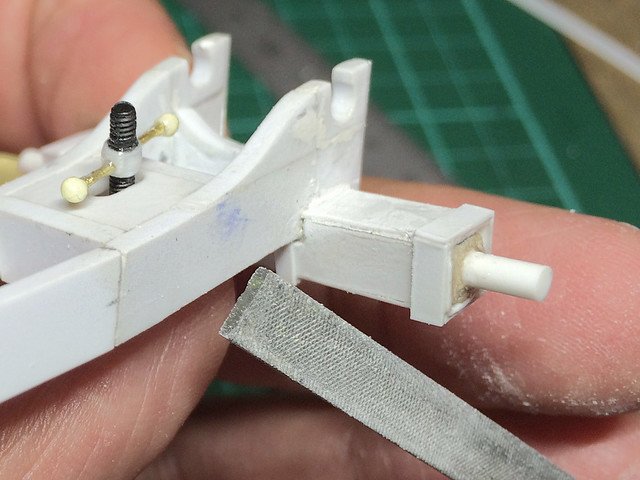 |
| There were a lot of sloppy joins to fix...At least I have a template for any further gun carriages I make. |
Having gotten the house keeping out the way I started adding some extra detail to the front end of the carriage. It's all very cosmetic, I'm not basing my additions on any particular historic reference...
Just enough extras to make the carriage look as if it might be based on something real! (Which it isn't. Any resemblance to something real is purely coincidental.)
It's all going to be painted black anyway (more about the colour scheme in a minute) so I didn't go wild with the amount of detail that I added. But I think it looks OK?
Quick check to get a feel for how it'll look like when done...
The carriage paint scheme
I had a good think and I decided I wanted something that stood out a little and would be uniquely 'Moletarian'. I didn't want something bland like field grey or natural bare wood and metal so I picked a colour scheme for my Molatarian artillery pieces that would look smart and unique.
I toyed around with colour combinations based on the national colours of Molatero - black, purple, orange and white - and out of these I decided black was a good choice for the main base colour. It's a practical choice, quite 'tactical' and seems a feasible in the context of late 19th Century military artillery. But what colour to choice for the contracting colour? (Plain black would be a bit boring.)
Purple was a immediate 'no' for me (yuck), and orange didn't seem right either. Which left white. Hmmm, black with white detailing - that sounded pretty attractive and sort of believable for a circa 1870 military artillery scheme.
So, I'll start with a base coat of Humbrol black matt acrylic...
Next: Carriage painting completed and onto the painting of the Gatling Gun itself.
Labels:
1/32,
AiP,
artillery,
Molatero,
plastic,
Project 11,
scratch build
Friday, 28 August 2015
AiP 1/32 Gatling Gun carriage re-made - Part 1.5
...I wasn't happy. The job I made of the new Gatling carriage just wasn't quite right (a reminder)...
The problem is that the gun's breech mechanism is laying right on top of the 'box' where the elevation mechanism should go (a wheel and screw arrangement which lifts and lowers the gun). At the moment there is no room for the screw to go between the box and the breech. Here's an idea of how it should look...
I hated to acknowledge what obviously had to be done...I was going to have to raise the trunnion holes in order to make space between the carriage and gun breech. Bugger!
Well, after a lot of cursing and sawing away with my craft knife (must buy a micro-saw) I detached the end of the carriage with the trunnion holes and added a new 'end' piece and then re-attached the trunnion pieces on top on the new end pieces...Phew!
It's all getting a bit slap-dash now and a little messy but if I can get this first attempt to work and look right I'll know how to tackle any further carriages I make.
Messy maybe, but it did the trick...
I now have adequate space between the breech and 'elevation box' on the carriage (don't know if that's the correct term for it) to insert the screw mechanism. Obviously, now I'm satisfied, I will have to tidy the job up, but I'll add the elevation screw first.
Well, it's not the best piece of scale modelling but it's better than the original AiP attempt (sort of). I really wanted to do a little wheel but just couldn't find a suitable part in my scraps box.
I'm back on course now - this model has turned out to be a bit of a prototype really, as I work out the best way to make a 1/32 gun carriage with my chosen materials. Though I hope that once I have added the extra detail and painted this attempt it will look OK.
The good thing about modifying the way the gun attached to the carriage - and raising it - is that it solves one of the main issues with the original AiP model. It get's rid of the annoying 'droopy gun'!
Next: Adding the detail and painting.
Historical note: I mentioned that this form of Gatling - mounted on a conventional artillery gun carriage - was an earlier form of the gun. But there seems to have been another reason this 'heavy' carriaged version of the gun was in use - apparently it was useful for engaging fixed (or fortified) positions. In this case the ability to transverse - sweep left and right quickly - was not such a big issue (perhaps). I'm still reading but what amazed me was how very large calibre automatic guns were in use quite early on, guns like the Hotchkiss and Maxim 'Pom-Poms' were mounted on gun carriages (Wikipedia: "...37 mm Nordenfelt-Maxim or "QF 1-pounder" introduced during the Second Boer War, the smallest artillery piece of that war. It fired a shell one pound in weight accurately over a distance of 3,000 yd (2,700 m)".
The problem is that the gun's breech mechanism is laying right on top of the 'box' where the elevation mechanism should go (a wheel and screw arrangement which lifts and lowers the gun). At the moment there is no room for the screw to go between the box and the breech. Here's an idea of how it should look...
 |
| The elevation screw (inside red circle) lifts and lowers the gun barrels. |
I hated to acknowledge what obviously had to be done...I was going to have to raise the trunnion holes in order to make space between the carriage and gun breech. Bugger!
 |
| Damn! No space between the breech and the elevation 'box'. |
Well, after a lot of cursing and sawing away with my craft knife (must buy a micro-saw) I detached the end of the carriage with the trunnion holes and added a new 'end' piece and then re-attached the trunnion pieces on top on the new end pieces...Phew!
 |
| A bit rough and ready, but whatever works! |
It's all getting a bit slap-dash now and a little messy but if I can get this first attempt to work and look right I'll know how to tackle any further carriages I make.
Messy maybe, but it did the trick...
I now have adequate space between the breech and 'elevation box' on the carriage (don't know if that's the correct term for it) to insert the screw mechanism. Obviously, now I'm satisfied, I will have to tidy the job up, but I'll add the elevation screw first.
Well, it's not the best piece of scale modelling but it's better than the original AiP attempt (sort of). I really wanted to do a little wheel but just couldn't find a suitable part in my scraps box.
I'm back on course now - this model has turned out to be a bit of a prototype really, as I work out the best way to make a 1/32 gun carriage with my chosen materials. Though I hope that once I have added the extra detail and painted this attempt it will look OK.
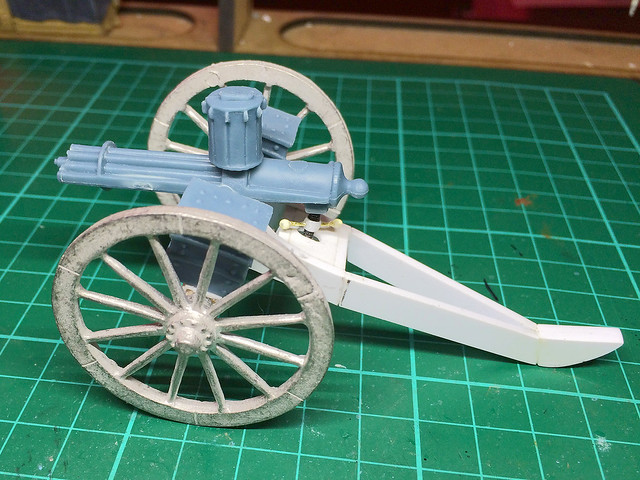 |
| Back to square one, but I'm a bit happier now! |
The good thing about modifying the way the gun attached to the carriage - and raising it - is that it solves one of the main issues with the original AiP model. It get's rid of the annoying 'droopy gun'!
Next: Adding the detail and painting.
Historical note: I mentioned that this form of Gatling - mounted on a conventional artillery gun carriage - was an earlier form of the gun. But there seems to have been another reason this 'heavy' carriaged version of the gun was in use - apparently it was useful for engaging fixed (or fortified) positions. In this case the ability to transverse - sweep left and right quickly - was not such a big issue (perhaps). I'm still reading but what amazed me was how very large calibre automatic guns were in use quite early on, guns like the Hotchkiss and Maxim 'Pom-Poms' were mounted on gun carriages (Wikipedia: "...37 mm Nordenfelt-Maxim or "QF 1-pounder" introduced during the Second Boer War, the smallest artillery piece of that war. It fired a shell one pound in weight accurately over a distance of 3,000 yd (2,700 m)".
Labels:
1/32,
AiP,
artillery,
conversion,
Molatero,
plastic,
Project 11
Friday, 29 May 2015
Give the man a stripe!
A little aside with my Gatling crew regarding how I apply the trouser stripes. Now up until now I have hand painted the strips and being a graphic designer by trade I am a little persnickety about how straight a straight line is!
While perusing through my local model store I came across a decal product that I thought might help speed up and make more accurate trouser stripes. It's called Model Technics TrimLine...
What immediately caught my eye was that it was available in the very bright orange that I have been painting my Molatarian soldiers' stripes. Basically it's a long roll of self-adhesive vinyl strips of varying widths - three of which are ideal for the use I have in mind. (There is a range of colours and the roll is about three quid.)
I had two concerns about this product - how flexable is it (can it conform to bent legs) and how thick are the stripes (would it stand out as being obviously a stuck on decal). Only one way to find out...
Well, while the stripes are not too thick they aren't all that flexible - they are really designed for coach-lining models and being applied in straight lines. So getting then to curve to the natural pose of a toy soldiers leg was a bit of a challenge and I had to do a wee bit of cutting with a scalpel to get them to 'bend' the way I wanted.
However, with perseverance I eventually managed to get them to applied in an acceptably realistic manner...
OK, so they don't bend very smoothly but I reckon it's good enough - to be honest I don't think I could have tried the TrimLine out on more difficult poses (except perhaps kneeling). As the majority of toy soldier models are in straight legged poses most will be a lot easier work than these little fellows.
The next issue was just how noticeable these stripes would be as transfers as I was a little worried they would look stuck on. But they actually did look too bad (they are quite thin) and there was no noticeable 'white edge' to them to give the game away. So I carried on and went to the glossing stage...
As I had hoped the application of a coat of gloss seemed to smooth out any obvious 'step' between model and stripe, and the effect was to blend the transfer 'in'. At a distance the stripe looks as if it is just very carefully painted on! (Lovely straight edges!)
Experiment a success I should say - though I am probably open to accusations of 'cheating'. Still, when you think of the work involved in painting a whole regiment of these chaps (20 figures say) - that's 40 stripes in all and that's a lot of time and concentration. TrimLine would really speed up the creation of my figures and is an improvement over my less than perfect line painting methods.
(I am sure there are some modellers out there that would make short work of painting stripes freehand - but I'm afraid I am just not one of them.)
While perusing through my local model store I came across a decal product that I thought might help speed up and make more accurate trouser stripes. It's called Model Technics TrimLine...
What immediately caught my eye was that it was available in the very bright orange that I have been painting my Molatarian soldiers' stripes. Basically it's a long roll of self-adhesive vinyl strips of varying widths - three of which are ideal for the use I have in mind. (There is a range of colours and the roll is about three quid.)
I had two concerns about this product - how flexable is it (can it conform to bent legs) and how thick are the stripes (would it stand out as being obviously a stuck on decal). Only one way to find out...
Well, while the stripes are not too thick they aren't all that flexible - they are really designed for coach-lining models and being applied in straight lines. So getting then to curve to the natural pose of a toy soldiers leg was a bit of a challenge and I had to do a wee bit of cutting with a scalpel to get them to 'bend' the way I wanted.
However, with perseverance I eventually managed to get them to applied in an acceptably realistic manner...
OK, so they don't bend very smoothly but I reckon it's good enough - to be honest I don't think I could have tried the TrimLine out on more difficult poses (except perhaps kneeling). As the majority of toy soldier models are in straight legged poses most will be a lot easier work than these little fellows.
The next issue was just how noticeable these stripes would be as transfers as I was a little worried they would look stuck on. But they actually did look too bad (they are quite thin) and there was no noticeable 'white edge' to them to give the game away. So I carried on and went to the glossing stage...
As I had hoped the application of a coat of gloss seemed to smooth out any obvious 'step' between model and stripe, and the effect was to blend the transfer 'in'. At a distance the stripe looks as if it is just very carefully painted on! (Lovely straight edges!)
Experiment a success I should say - though I am probably open to accusations of 'cheating'. Still, when you think of the work involved in painting a whole regiment of these chaps (20 figures say) - that's 40 stripes in all and that's a lot of time and concentration. TrimLine would really speed up the creation of my figures and is an improvement over my less than perfect line painting methods.
(I am sure there are some modellers out there that would make short work of painting stripes freehand - but I'm afraid I am just not one of them.)
Labels:
1/32,
accessories,
AiP,
artillery,
effects,
painting,
plastic,
Project 11
Sunday, 24 May 2015
Molatarian Gatling Gun crew - progress
OK, I mentioned that I had a bit of an issue with the heads of the AiP gunners because I had removed the original pith helmets. To recap taking off the 'big hat' revealed that AiP had only done the most cursory sculpting of the head - particularly of the gunnery officer - as the hat largely obscured his features (as did the NCO/Officer's binoculars)...
This left me with a little rebuilding to do as my Molatarian hats were more 'off the face'. So off I went with the Milliput and did some very amateurish 'plastic surgery' (having seen my efforts I can guarantee that I will not be having any visits from crime bosses who need a change of identity)!
Not great! But I feel a little better - plus it's given them 'the personal touch' so they are a little unique (even if it's not in a good way). :)
Just a minor point, I'm using (Quick Drying) Pollyfilla for the bases now. It's quick and easy to apply, dries quickly (naturally) and creates an interesting texture. Obviously this does make my bases quite thick (or is it deep?) as I already mount my figures on 3mm MDF bases, but I prefer the extra weight and stability this gives. It does mean my figures might be slightly taller on the game table than other peoples' though.
Link to UK MDF figure bases: Warbases
Well, that's the 'hard' work done, and so it's on to the paint preparation process. As before I used some spray on lacquer (Wilko's cheapest) just to smooth out the surface of the figures and help give them some rigidity. Then it was a quick spray of some white automotive primer...
The primer actually serves to highlights any overly rough areas that might need some additional attention. So it's out with the scalpel again to do some remedial work and then another quick squirt of white!
Satisfied with this, I move on to the base painting. As on my test I tend to do the first coat with my Vallajo Model Color paints before moving on to the more expensive and tricky Tamiya paints for the final coat...
The Vallejo colours are a bit flatter but help provide a good base for the bright Tamiya colours, which need help to create a good opaque coverage. I admit this is - by the end - a lot of coats of different types of paint, but you are looking for that 'traditional toy soldier' look which is epitomised by flawless and flat colour coverage. So it's worth going the extra yard to achieve this.
Well, that's these chaps well on their way to being finished so we will turn our attention to the Gattling Gun itself now.
NEXT: Head scratching about the AiP 'Gatling' and how to approach this model.
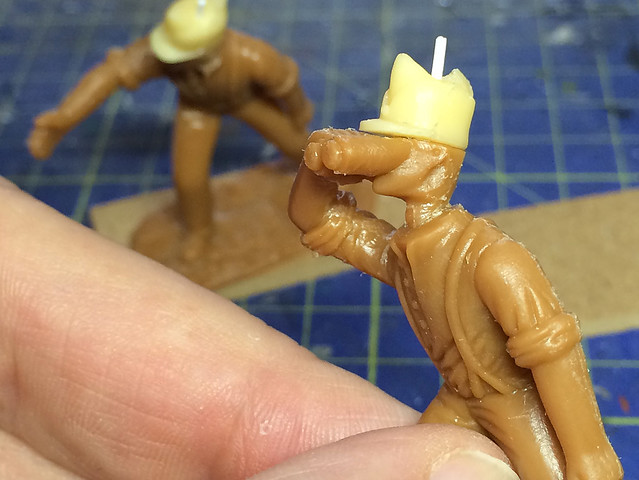 |
| "Oh gov! Me neck's so skinny and me ears have shrunk!" |
Not great! But I feel a little better - plus it's given them 'the personal touch' so they are a little unique (even if it's not in a good way). :)
Just a minor point, I'm using (Quick Drying) Pollyfilla for the bases now. It's quick and easy to apply, dries quickly (naturally) and creates an interesting texture. Obviously this does make my bases quite thick (or is it deep?) as I already mount my figures on 3mm MDF bases, but I prefer the extra weight and stability this gives. It does mean my figures might be slightly taller on the game table than other peoples' though.
Link to UK MDF figure bases: Warbases
Well, that's the 'hard' work done, and so it's on to the paint preparation process. As before I used some spray on lacquer (Wilko's cheapest) just to smooth out the surface of the figures and help give them some rigidity. Then it was a quick spray of some white automotive primer...
The primer actually serves to highlights any overly rough areas that might need some additional attention. So it's out with the scalpel again to do some remedial work and then another quick squirt of white!
Satisfied with this, I move on to the base painting. As on my test I tend to do the first coat with my Vallajo Model Color paints before moving on to the more expensive and tricky Tamiya paints for the final coat...
The Vallejo colours are a bit flatter but help provide a good base for the bright Tamiya colours, which need help to create a good opaque coverage. I admit this is - by the end - a lot of coats of different types of paint, but you are looking for that 'traditional toy soldier' look which is epitomised by flawless and flat colour coverage. So it's worth going the extra yard to achieve this.
Well, that's these chaps well on their way to being finished so we will turn our attention to the Gattling Gun itself now.
NEXT: Head scratching about the AiP 'Gatling' and how to approach this model.
Sunday, 17 May 2015
Molatarian Gatling gunners - test figure, complete...
Well, the test figure is complete bar the gloss coat. But it's really nice to get back into the swing of FLW 'traditional' toy soldier painting - I had forgotten how relaxing it is. Then again painting with Tamiya paints can be challenging, they are like treacle and have to be thinned with Tamiya's own thinner for best results...
The reason I like the Tamiya paints is because they do have a nice opaque quality to them and look a little like enamels, which suits this job (sometimes the Vallejo paints can be a bit thin resulting in a semi-transparent and streaky finish). But I have given up trying to use the the Tamiya for my normal plastic modelling, where the thinner opacity is an advantage for washes and weathering effects.
I chose a colour pattern for the Broadwell drums (Gatling magazines) incorporating 'brass' side panels. I will probably include a brass element on the gun itself with the overall colour of it and the gun carriage being black. I do think the Gatling rather splendid when done in brass!
(I *believe* the use of brass is an indication of earlier models of the Gatling [?]. Certainly by the Boer War the British Army seemed to prefer a fully painted Gatling - perhaps for tactical reasons. I really must buy Osprey's book on the Gatling come pay day.)
Anyway, now I'm happy I remember the process for painting FLW figures I'll get started on the other two members of the Gatling team...
Same procedure, the only noticeable difference being the stance of the figures which will require the use of larger rectangular bases. AiP have chosen to do quite dynamic poses for these gunner, I suppose you could say they are less 'traditional' compared to the style of original Edwardian toy soldiers but they look interesting.
However, there were a couple of problems while doing the head conversions. It turns out that there were a few shortcuts AiP had taken with the sculpting of the heads because they were effectively hidden by the big pith helmet the figures came with. Removing the helmets revealed my chaps had 'skinny' necks and practically no ears!
So now I have fitted my Molatarian hats I will have to rebuild some of the features of the heads. But no biggy as I kind of do that anyway with the extra facial hair I decided to do.
Next: The figures shouldn't take too long so now it's time to start on the Gatling Gun!
 |
| It was pointed out to me that this chap looks a like Chuck Norris! |
I chose a colour pattern for the Broadwell drums (Gatling magazines) incorporating 'brass' side panels. I will probably include a brass element on the gun itself with the overall colour of it and the gun carriage being black. I do think the Gatling rather splendid when done in brass!
(I *believe* the use of brass is an indication of earlier models of the Gatling [?]. Certainly by the Boer War the British Army seemed to prefer a fully painted Gatling - perhaps for tactical reasons. I really must buy Osprey's book on the Gatling come pay day.)
Anyway, now I'm happy I remember the process for painting FLW figures I'll get started on the other two members of the Gatling team...
Same procedure, the only noticeable difference being the stance of the figures which will require the use of larger rectangular bases. AiP have chosen to do quite dynamic poses for these gunner, I suppose you could say they are less 'traditional' compared to the style of original Edwardian toy soldiers but they look interesting.
However, there were a couple of problems while doing the head conversions. It turns out that there were a few shortcuts AiP had taken with the sculpting of the heads because they were effectively hidden by the big pith helmet the figures came with. Removing the helmets revealed my chaps had 'skinny' necks and practically no ears!
So now I have fitted my Molatarian hats I will have to rebuild some of the features of the heads. But no biggy as I kind of do that anyway with the extra facial hair I decided to do.
Next: The figures shouldn't take too long so now it's time to start on the Gatling Gun!
Labels:
1/32,
AiP,
Boer War,
British,
conversion,
painting,
plastic,
Project 11
Thursday, 14 May 2015
Molatarian Gatling gunners - test figure, undercoat
Moving on to the painting of my Gatling crew test figure I have to solve one minor puzzle - how best to paint the trouser stripes. Better modellers than I might do this freehand, but even if I had the brush skill to do this there is the small matter of the figures arms being in the way!
Once I solve how to do the stripes the rest is pretty straight forward so let's get that out the way...
For these undercoat colours I am using my normal Vallejo Model Color paints. I began by painting a broad line down the side of the trousers, not easy with the magazines in the way. Then I cut some strips of masking tape to the correct width of the stripe I wanted...
I can then paint over these which - hopefully - will give me a fairly neat guideline when I peal the tape off. It should just, then, be a matter of neatening these up with the Tamiya top coat.
Anyway, the stripes dealt with I can move on to the rest of the figure. The more opaque the base coat the more successful the Tamiya top coat will be - the Tamiya paint is tricky stuff so a good foundation coat really makes the job a little easier.
The painting was a little rough, but that doesn't matter so much as I do the real neatening up when I do the top coat. Still it gives an idea of what the finished figure might look like.
Update: Haven given the black trousers time to dry I removed the strips of masking tape to reveal the orange stripes. It sort of worked, a bit rough at the edges but wasn't meant to be a 'finished' effect but rather a guide for when I paint the top coat.
Once I solve how to do the stripes the rest is pretty straight forward so let's get that out the way...
For these undercoat colours I am using my normal Vallejo Model Color paints. I began by painting a broad line down the side of the trousers, not easy with the magazines in the way. Then I cut some strips of masking tape to the correct width of the stripe I wanted...
I can then paint over these which - hopefully - will give me a fairly neat guideline when I peal the tape off. It should just, then, be a matter of neatening these up with the Tamiya top coat.
Anyway, the stripes dealt with I can move on to the rest of the figure. The more opaque the base coat the more successful the Tamiya top coat will be - the Tamiya paint is tricky stuff so a good foundation coat really makes the job a little easier.
The painting was a little rough, but that doesn't matter so much as I do the real neatening up when I do the top coat. Still it gives an idea of what the finished figure might look like.
Update: Haven given the black trousers time to dry I removed the strips of masking tape to reveal the orange stripes. It sort of worked, a bit rough at the edges but wasn't meant to be a 'finished' effect but rather a guide for when I paint the top coat.
Wednesday, 13 May 2015
Converting AiP's 1880/1902 British gunners into Molatarian gunners
Technically speaking turing AiP's British Gatling crew into my FLW Motaraians is a pretty straight forward conversion. As the 'short sleeve' uniform was pretty universal for artillery men in action during this period the main body of the model can remain unchanged. Only the hat need be modified.
I already decided that the Romanian style 'capela' field cap would be the standard military dress for Molaterian lower ranks and had made a model of this which I then had duplicated by my brother. So it should be a case of a straight swap.
Left: The Romanian 'capela' field cap. I had imagined my FLW creation of Molatero as being an Eastern European nation *near* where Romania lays in our - real - modern day Europe. So, naturally, my fictional realm would share much of the cultural flavour of what we would call the Balkan Peninsula.
First I have to cut off the British pith helmet, but even this is easy as the soft plastic of the model works in my favour. All that's required is a sharp craft knife and a steady hand and off comes the top of the my soldier's head just above the eye-brows...
One small consideration is facial hair. At the moment the soldiers all sport a very neat and very British looking moustache! But my preference is for rather more elaborate whiskers and I also favour big bushy beards as the fashionable trend for the well dressed Molaterian!
As I mentioned, the capelas are already made - in resin - and I have a bag of donor heads ready to either transplant directly onto the necks of model hosts or I can cut off just the hat and pop that on a head, as I have described above...
A little gruesome, but this Frankenstein approach is an easy and fun way of personalising commercial toy soldiers that even the beginners can employ. It's part of the FLW philosophy to 'do your own thing' and I really like the fact I can create my own mythology (if that's the right word) for my little army, with it's own traditions and fashions. It means that my army is completely unique from that of another FLW enthusiast's creation, even if we both use the same commercial soldiers. (And nobody can tell you that your design isn't historically correct!)
Anyhoo, having super-glued your replacement part onto the host body - and I tend to try and include some sort of securing pin where I can - it's time to fill any gaps with your favourite modelling putty.
And now it's a straight forward mounting and painting job. The process I have adopted - for soft plastic figures - is to apply a couple of coats of spray varnish onto the bare model before adding a colour priming coat. This helps stiffen the plastic, which is particularly important with riflemen, where soft plastic guns are notorious for bending.
Note: It should be remembered that if your soft plastic soldier does come out the box with a bent part (oh er, Matron!) that this can usually be remedied by immersing the part in very hot water for a short time and then pulling the part back into shape. You then quickly dunk the part into cold water, which 'sets' the new shape, and re-hardens the plastic molecules.
Having allowed the varnish a good amount of time to dry properly you can then add the colour priming coat of paint. Colour choice for primer vary but as my Molatarians are rather brightly coloured little chaps I prefer to start with a white primer - usually Hycote Matt White aerosol - as that makes primary colours 'pop'. It can be a little tricky painting dark colours onto white as you may have to apply a couple of coats to ensure opaqueness but it's worth it.
And now your little soldier is ready for painting. I'll pause here, as I'm chomping at the bit to make the same amount of progress with the Gatling Gun piece.
Next: Tamiya paints (it's like painting with treacle)!
 |
| A British Gatling Gun detachment using 'high capacity' Broadwell Drums, South Africa c.1879 These fine chaps are not in 'shirt sleeve' order but are the period templates for the AiP Gatling set. Turning them into 'Eastern Europeans' is my next challenge. Note the beards! Source: National Army Museum Copyright |
Left: The Romanian 'capela' field cap. I had imagined my FLW creation of Molatero as being an Eastern European nation *near* where Romania lays in our - real - modern day Europe. So, naturally, my fictional realm would share much of the cultural flavour of what we would call the Balkan Peninsula.
First I have to cut off the British pith helmet, but even this is easy as the soft plastic of the model works in my favour. All that's required is a sharp craft knife and a steady hand and off comes the top of the my soldier's head just above the eye-brows...
One small consideration is facial hair. At the moment the soldiers all sport a very neat and very British looking moustache! But my preference is for rather more elaborate whiskers and I also favour big bushy beards as the fashionable trend for the well dressed Molaterian!
As I mentioned, the capelas are already made - in resin - and I have a bag of donor heads ready to either transplant directly onto the necks of model hosts or I can cut off just the hat and pop that on a head, as I have described above...
A little gruesome, but this Frankenstein approach is an easy and fun way of personalising commercial toy soldiers that even the beginners can employ. It's part of the FLW philosophy to 'do your own thing' and I really like the fact I can create my own mythology (if that's the right word) for my little army, with it's own traditions and fashions. It means that my army is completely unique from that of another FLW enthusiast's creation, even if we both use the same commercial soldiers. (And nobody can tell you that your design isn't historically correct!)
Anyhoo, having super-glued your replacement part onto the host body - and I tend to try and include some sort of securing pin where I can - it's time to fill any gaps with your favourite modelling putty.
And now it's a straight forward mounting and painting job. The process I have adopted - for soft plastic figures - is to apply a couple of coats of spray varnish onto the bare model before adding a colour priming coat. This helps stiffen the plastic, which is particularly important with riflemen, where soft plastic guns are notorious for bending.
Note: It should be remembered that if your soft plastic soldier does come out the box with a bent part (oh er, Matron!) that this can usually be remedied by immersing the part in very hot water for a short time and then pulling the part back into shape. You then quickly dunk the part into cold water, which 'sets' the new shape, and re-hardens the plastic molecules.
 |
| A nice big bushy beard! Nothing say 19th Century more than a extravagant display of facial whiskers...On a man of course, otherwise that just says 'carnival'! |
Having allowed the varnish a good amount of time to dry properly you can then add the colour priming coat of paint. Colour choice for primer vary but as my Molatarians are rather brightly coloured little chaps I prefer to start with a white primer - usually Hycote Matt White aerosol - as that makes primary colours 'pop'. It can be a little tricky painting dark colours onto white as you may have to apply a couple of coats to ensure opaqueness but it's worth it.
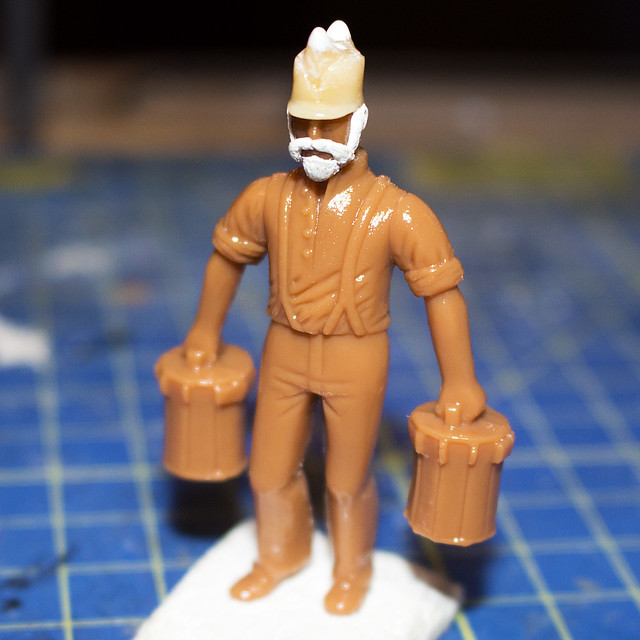 |
| Hard to tell but the figure has now had two good coats of acrylic gloss varnish. This not only helps stiffen the soft plastic but also somewhat smooths out some of the rough edges. |
 |
| The white primer applied we now have a nice bright canvas onto which we can apply the colour coats. |
And now your little soldier is ready for painting. I'll pause here, as I'm chomping at the bit to make the same amount of progress with the Gatling Gun piece.
Next: Tamiya paints (it's like painting with treacle)!
Subscribe to:
Posts (Atom)



